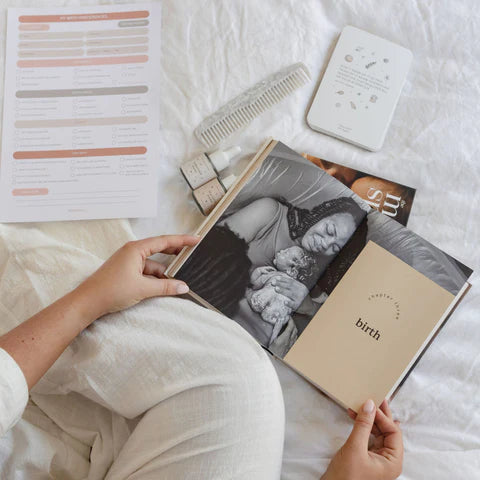There’s a lot of talk about what to expect when you’re expecting; but what about what to expect when your birth date arrives? The truth is, you really want to expect the unexpected, or at the very least, plan for it.
Here at biglittlethings, we’re all about setting mamas up with the knowledge you need to make an informed decision. Having all the tools you can when different scenarios happen (as they will - because that’s the nature of birth) means you can be prepared to adjust when and how you need.
What does birth preference mean?
We’re going to let you in on a not-so-well-kept secret. During birth, things don’t always go to plan. This doesn’t always mean something bad, just that unexpected scenarios might pop up.
Whatever it is, it can feel daunting when your ‘plan’ goes out the window. Which is why we don’t like advocating for birth plans, rather than birth preferences. Reviewing your mindset around this means you’ll likely be more prepared to adjust if you need to.
Does everyone need a birth plan?
If the idea of having to create a birth plan (amongst every other item on your to-do list) sends you into a panic, don’t worry, because having a plan isn’t necessary for birth. However, even having a small list of birth preferences can be useful to help give you more control over the birthing process, understand what you can expect next, make more informed decisions about what is happening to your body, and even help you work through the psychological aspect of giving birth.
So, while it’s not necessary to have a plan before birth, we highly recommend having a rough list of preferences as a tool to help you on the day.

When to write birth plan?
You can start thinking about what you want your birthing process to look like as early as your second trimester, giving you time to chat with your partner and medical care team about how you want to proceed or what recommendations they have based on the health of you and your baby.
However, you probably don’t need to put pen to paper or start properly communicating your preferences with your birthing team until midway through the third trimester. We recommend doing this sometime between weeks 30 and 34, around the same time you’re thinking of packing your hospital bag.
Tips for creating a birth plan
Now that you’re ready to start writing down your birth preferences, how do you decide what you want for yourself and your baby? For us, it’s all about having enough information for informed consent or informed refusal.
Using the B.R.A.I.N acronym is a great place to start:
- Benefits – What are the benefits of making this decision?
- Risks – What are the risks involved?
- Alternatives – Are there any alternatives you might be more comfortable with? (and go through B.R.A.I.N with each of these).
- Intuition – What is your gut telling you to do? Is there a certain way you’ve always envisioned giving birth?
- Nothing – What happens if you do nothing? Can you wait it out? Are there more risks involved?
Remembering B.R.A.I.N when creating your birth plan, or when asked a question by a member of your medical team, will help you decide what’s right for you. It can also be helpful during the thick of it if you’re going through the ladder of intervention.

What should be included in a birth plan?
Pregnancy birth plan
First up, it’s time to decide where you want to give birth. Will this be at the hospital (and which one) or at home?
Who do you want to be with you on the day? What will your partner’s involvement in the birth be? Will you have another personal support person there, or the support of a private doula?
Finally, what other elements are important to you during birth? Are there any cultural aspects you may want to include?
Labour and delivery preferences
Next up is the lead-up to delivery and how you manage this. Will you be labouring at home for as long as possible, or do you have a private clinic to go to?
Think about the types of relaxation techniques you want to make use of, particularly during those early stages of labour. Deep breathing, massage, music, slow walking, having a bath, meditation, acupressure and even using a TENS machine are just some of the ways other mamas manage contractions throughout labour.
Having a toolkit of birthing positions can also be useful as you may want to change positions a few times throughout labour. Do you want to be standing, lying down, on all fours, submerged in water, or using an exercise ball?

Birth plan options
There are a lot of choices when it comes to delivery, and each of them comes with more decisions of their own.
Vaginal birth plan
Many mamas decide they want to have a natural birth, delivering vaginally with no pain management. If this is your plan, it’s still important to know what other types of delivery might be available to you. Suddenly needing interventions or choosing another birth style on the day can be upsetting, so knowing what the alternatives are in advance could help ease some of that distress.
Birth plan for C-section
If a planned C-section is on the cards for you (or you want to be prepared in the event of an emergency C-section), think about what this entails and how you want it to go. How can you prepare for pre-delivery fasting, blood tests, or having a catheter? Who can come into surgery with you, will you be under a general anaesthetic, or do you want the option of a maternal-assisted caesarean? Can you ask for your birth playlist to be played in theatre, or other comforts that could help relax you? And how can you plan for your first moment holding baby (if possible), or will your birth partner be there to show you your new bundle of joy?

Birth plan for induction
If you have specific health needs, are more than 41 weeks pregnant, or labour isn’t going as quickly as you’d like, the option to induce may be brought up (or not, if you’d prefer not to be asked about this at all). Whatever the reason, knowing what is involved can help you make an informed decision on things like the type of induction (balloon catheter, prostaglandin gel, oxytocin drip, or artificially breaking your waters) as well as how you’ll be able to go through the delivery process (ie: if you’re connected to an IV so have less movement).
Water birth plan
Aside from knowing what your first and second birth preferences are, if you’re having a water birth it can also be useful to think about things like what to wear (if anything), what the temperature of the water is going to be, what position you want to be in, and how (and where) you want your support person involved.
Including pain management in my birth plan
Everyone experiences pain differently and what might work for you might not work for someone else, so think about what sort of pain management (if any) you want to consider during delivery. The most common pain relief options offered during birth are nitrous oxide gas, a pethidine injection, or epidural anaesthesia. Use B.R.A.I.N to think about which of these might be most suitable for you, at what stage during labour you can have them, and what other procedures (ie: having a catheter after an epidural) may be involved.

Planning for birthing interventions
As much as you can know what your preferences are, knowing what interventions might be offered to you is just as important. Could an emergency C-section be on the cards? Has your medical team offered you an episiotomy or suggested the assistance of a vacuum or forceps? Where possible, look at the ladder of intervention and how each stage is broken down to know what your preferences are at what points. It’s important to discuss these with your birth partner so they can advocate on your behalf if you’re not in a position to. At the very least, knowing what each intervention entails can help you give informed consent (or informed refusal) when the time comes.

Birth plan for baby
You’ve gone through delivery (yay!) and now your baby is finally here. So what else should you consider in your birth plan?
Do you want to have skin-to-skin contact right away (or is this even a possibility?) Does your birth partner want to cut the umbilical cord? Do you want to try and breastfeed straight away? What will you do with your placenta once you deliver it (and do you consent to an oxytocin injection to help this process?) Have you stored expressed colostrum you want to feed your baby? What sort of tests will you opt into for baby in the first few hours and days?
Communicating birth preferences
Now you’ve decided what your birth plan looks like, it’s time to let people know. Discuss this with your partner to make sure you’re on the same page, particularly if they’re going to be in the delivery room and may need to communicate your wishes for you.
Writing your preferences down can be a great way to have them outlined both before and during the big day, but it’s also important to discuss your wishes with your pregnancy care and delivery team. We suggest doing this during one of your third-trimester appointments to make sure you communicate your wishes with them properly, take their professional medical advice into consideration, and go through any additional factors or risks to consider the closer you get to birth.
Having a list of birth preferences is all about helping you make an informed decision when it comes to your body and your baby. So whether it’s a plan you have written down, or just an idea in your head of how you want things to go, consider your options and get ready to welcome your little one into the world the way you want.
are you expecting? join your due month club now for all the exclusive things.



